Lion850
National Hazard
   
Posts: 514
Registered: 7-10-2019
Location: Australia
Member Is Offline
Mood: Great
|
|
Colourful Gallium compounds
Gallium generally makes white compounds and my challenge was to make colourful gallium containing compounds.
Vano reported one here https://www.sciencemadness.org/whisper/viewthread.php?tid=15...
and he also previously obtained a yellow ppt that could well have been gallium chromate. Today I tried to see if I could repeat Vano's result and get
a yellow chromate.
A clear solution containing 5.7g gallium chloride GaCl2 was to be reacted with a solution of 6.5g of potassium chromate K2CrO4, as below.
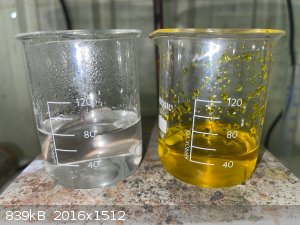
The potassium chromate solution was poured into the gallium chloride solution while it was stirred, both was at room temp. Immediately an orange color
appeared and an orange suspension formed. Initially the suspension appeared voluminous but it soon dissolved itself, below shows after 30 seconds or
so:
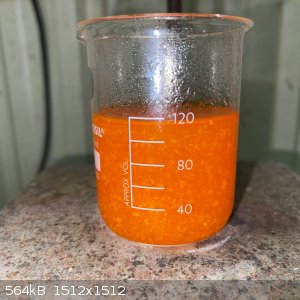
Eventually all dissolved into a orange-red solution. I then boiled down the solution to see if anything started to crystallise. After some time of
boiling a yellow ppt suddenly appeared. This ppt seemed insoluble once it formed. It did not re-dissolve when more water was added.
The yellow ppt was filtered off and dried on a steam bath. The result was 4.8g of soft but heavy powder.
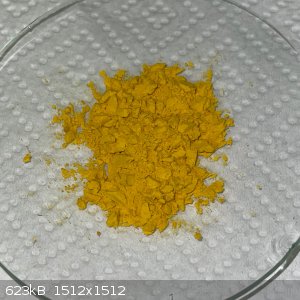
I boiled the orange-red filtrate down further, it became more red in color but no more of the yellow ppt formed. Once around 30ml it was evaporated to
dryness on a steam bath.
It seemed to contain water of crystallization that made it wet at the steam bath temperature, but which it then re-absorbed when it cooled. After many
hours on the steam bath I eventually had a product that was reasonably dry at room temperature. Below shows the product still hot and appearing moist:
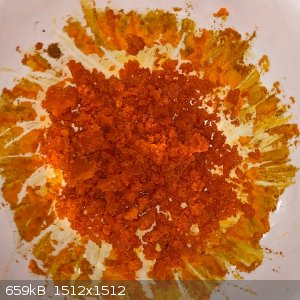
But once at room temp it appeared more orange and quite dry. 9.3g was recovered.
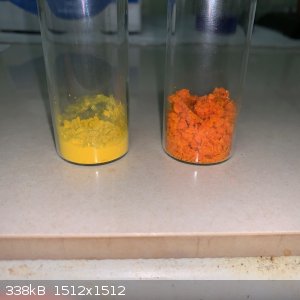
So what formed? From a total 12.2g starting materials I got a total of 14.1g products, but as mentioned the orange product appears to he hydrated.
But what happened in the reaction? Where is the chlorine (at no point was there any chlorine or HCl smell)? What formed? Is the gallium in the yellow,
or the orange, or both?
Need help here 
|
|
|
vano
National Hazard
   
Posts: 661
Registered: 22-3-2019
Location: Georgia
Member Is Offline
|
|
Thanks for sharing. It is very interesting. A few things make me think, for example can one be oxysalt and Second not?(not pure just some amount in
red one) Chloride can also form complexes. But compound really have characteristic color for chromate. Oxysalt may also have formed, with the chromium
anions remaining in the solution dissolved the rest of the gallium salt. I think the red mass contains quite a certain amount of gallium and not a
very small mass. In any case, you try something new that has no information and which is very interesting.
[Edited on 20-3-2021 by vano]
|
|
|
j_sum1
Administrator
       
Posts: 6220
Registered: 4-10-2014
Location: Unmoved
Member Is Offline
Mood: Organised
|
|
How do solutions of these respond in acidic/basic conditions?
Silver nitrate will assist in testing for chloride. Another test is a little dichromate and concentrated H2SO4. If a significant anount of chloride
is present (and water is absent) then you get chromyl chloride produced; which is deep red, oily-looking and very volatile.
|
|
|
vano
National Hazard
   
Posts: 661
Registered: 22-3-2019
Location: Georgia
Member Is Offline
|
|
I tried to find gallium chromate in 8 languages, but I could not find anything, as if no one was trying. Plus it is not in any language in Wikipedia
either. I wonder more now.
|
|
|
Lion850
National Hazard
   
Posts: 514
Registered: 7-10-2019
Location: Australia
Member Is Offline
Mood: Great
|
|
I can now add that the orange compound seems to be hygroscopic. After I scratched it out of the evaporating dish yesterday I left the dish on the
bench to see if the little bits that remained would get wet - and this next morning it was a pool or yellow-orange liquid.
|
|
|
Bedlasky
International Hazard
    
Posts: 1219
Registered: 15-4-2019
Location: Period 5, group 6
Member Is Offline
Mood: Volatile
|
|
Hi.
Solutions of GaCl3 are acidic - so if you mix it with chromate you get mix of chromate/dichromate. I think that yellow solid is gallium chromate and
orange solid is gallium dichromate.
|
|
|
vano
National Hazard
   
Posts: 661
Registered: 22-3-2019
Location: Georgia
Member Is Offline
|
|
Quote: Originally posted by Bedlasky  | Hi.
Solutions of GaCl3 are acidic - so if you mix it with chromate you get mix of chromate/dichromate. I think that yellow solid is gallium chromate and
orange solid is gallium dichromate. |
Of course if solution was acidic then dichromate os produced, but I don't think this red solid contains only gallium dichromate, As for yellow, I
believe it is chromate, I do not have any information, but for some reason I think it also contains oxysalt.
|
|
|
Lion850
National Hazard
   
Posts: 514
Registered: 7-10-2019
Location: Australia
Member Is Offline
Mood: Great
|
|
Thanks Bedlasky. I wonder where the potassium and chloride went. If it formed potassium chloride I would have expected to see white mixed in with the
orange (or in a distinct different band) when it evaporated on the steam bath. But there was no sign or a white salt anywhere.
Online I found mention of Cl4GaK here
https://lb.chemie.uni-hamburg.de/static/CN/2_G_galla.php?con...
and Cl7Ga2K here
https://lb.chemie.uni-hamburg.de/static/CN/2_G_galla.php?con...
But whether anything so exotic (to me!) formed and tied up the K and Cl I don't know.
|
|
|
Bedlasky
International Hazard
    
Posts: 1219
Registered: 15-4-2019
Location: Period 5, group 6
Member Is Offline
Mood: Volatile
|
|
Vano: What do you mean by oxysalt? You mean basic chromate? For that you need alkaline solution. I think that conclusion is clear and obvious. Btw.
Lion's compound is orange, not red.
Lion850: I agree that it is strange, that any KCl appeared. I doubt that you made chlorochromate, they are formed at very different conditions. Maybe
some double salt? Something like potassium gallium chromate/dichromate?
|
|
|
vano
National Hazard
   
Posts: 661
Registered: 22-3-2019
Location: Georgia
Member Is Offline
|
|
Bedlasky:I'm talking about yellow. I do not mean basic chromate. When I say oxysalt in general, in this case I mean oxychromate like Bismuth
oxychromate (BiO)2CrO4, It is theoretically possible for gallium (GaO)2CrO4 to form a similar compound, but i don't know exactly.
[Edited on 21-3-2021 by vano]
[Edited on 21-3-2021 by vano]
|
|
|
Bedlasky
International Hazard
    
Posts: 1219
Registered: 15-4-2019
Location: Period 5, group 6
Member Is Offline
Mood: Volatile
|
|
I never heard about oxysalts of gallium in solution. These salts like BiOI, SbOCl, POCl3, TiOSO4 etc. are formed by hydrolysis of salts, which aren't
stable in aqueous solution. But this isn't case of GaCl3. In solution of GaCl3 there is a mix of aqua and chloro complexes.
|
|
|
vano
National Hazard
   
Posts: 661
Registered: 22-3-2019
Location: Georgia
Member Is Offline
|
|
Yes i agree. But When you make gallium trichloride and at this time if you heat the solution a certain amount of chloride is hydrolyzed and obtained
GaCl(OH)2. It doesn't need high temperature. I never heard too about oxysalts of gallium in solution, But like the substances you mentioned, it can
simply be hydrolyzed like other gallium compounds. But various doubts arise in my mind as to why there is no information on the internet about gallium
chromate.
|
|
|
Bedlasky
International Hazard
    
Posts: 1219
Registered: 15-4-2019
Location: Period 5, group 6
Member Is Offline
Mood: Volatile
|
|
I think that there is no mention about gallium chromate because it doesn't have any particular interesting uses.
|
|
|
vano
National Hazard
   
Posts: 661
Registered: 22-3-2019
Location: Georgia
Member Is Offline
|
|
There are many similar compounds that are not used, but that does not mean that they are not prepared and there are no infos. For example the gallium
molybdate which I made and many more.
[Edited on 21-3-2021 by vano]
[Edited on 21-3-2021 by vano]
|
|
|
vano
National Hazard
   
Posts: 661
Registered: 22-3-2019
Location: Georgia
Member Is Offline
|
|
I found some compounds. Hg2(GaCl4)2, also Hg3(GaCl4)2 is exist, but it need vacuum and 240°C. But first one only need monovalent chloride and
gallium trichloride. I think it worth to try bromocomplex and other metals tetrahalogalates (chlorine and bromine).
It also forms hydroxoacetate Ga(CH3COO)3 · 3Ga(OH)3 · 3H2O. I think it is possible to manipulate hydroxide to give the compound a color.
Also some interesting compounds:
Oxalate complexes:
Na3Ga(C2O4)3
NaGa(C2O4)2
Molybdates:
Li3Ga(MoO4)3
LiGa(MoO4)2
hydroxides reaction:
Ga(OH)3 + NaOH = NaGaO2 + 2H2O (at 250°C)
It is interesting to use Cu, Co, or Ni hydroxides instead of NaOH.
Interesting Formic acid salt:
Ga(HCOO)3 ·0.75CO2 ·0.25H2O·0.25HCOOH
Reaction need gallium carbonate not hydroxide, because the reaction of gallium hydroxide and formic acid can only give the basic salt Ga(O2CH)(OH)2
|
|
|
Lion850
National Hazard
   
Posts: 514
Registered: 7-10-2019
Location: Australia
Member Is Offline
Mood: Great
|
|
All good & interesting info Vano, thanks.
|
|
|
vano
National Hazard
   
Posts: 661
Registered: 22-3-2019
Location: Georgia
Member Is Offline
|
|
Thanks
|
|
|
vano
National Hazard
   
Posts: 661
Registered: 22-3-2019
Location: Georgia
Member Is Offline
|
|
Monovalent copper metagallate. Also exist Ln4Ga2O9 and Ln3Ga5O12 i think lanthanides gallates will be colorful.
|
|
|
Bedlasky
International Hazard
    
Posts: 1219
Registered: 15-4-2019
Location: Period 5, group 6
Member Is Offline
Mood: Volatile
|
|
Al, Fe and Cr form A3H6[X(MoO4)6], X = trivalent metal ion, A = alkaline metal ion or NH4+. I think that gallium also forms this compound.
|
|
|
vano
National Hazard
   
Posts: 661
Registered: 22-3-2019
Location: Georgia
Member Is Offline
|
|
I agree it is possible. It need ammonium heptamolybdate right? Can you write whole reaction?
|
|
|
Bedlasky
International Hazard
    
Posts: 1219
Registered: 15-4-2019
Location: Period 5, group 6
Member Is Offline
Mood: Volatile
|
|
You can use any molybdate, but you must prepare it in sligthly acidic solution (pH cca 3-5).¨
7Ga3+ + 6(NH4)6Mo7O24 + 30H2O → 7(NH4)3H6[Ga(MoO4)6] + 15NH4+ + 6H3O+
|
|
|
vano
National Hazard
   
Posts: 661
Registered: 22-3-2019
Location: Georgia
Member Is Offline
|
|
Quote: Originally posted by Bedlasky  | You can use any molybdate, but you must prepare it in sligthly acidic solution (pH cca 3-5).¨
7Ga3+ + 6(NH4)6Mo7O24 + 30H2O → 7(NH4)3H6[Ga(MoO4)6] + 15NH4+ + 6H3O+ |
Thanks i will try. Maybe I will add gallium nitrate solution in sodium molybdate acidic solution. What do you think? Unfortunately i don't have
heptamolybdate.
|
|
|
Bedlasky
International Hazard
    
Posts: 1219
Registered: 15-4-2019
Location: Period 5, group 6
Member Is Offline
Mood: Volatile
|
|
Yes, you can do it. Solution of ammonium heptamolybdate have pH cca 5, so when you acidify your sodium molybdate to methyl red or methyl orange, you
have solution of sodium heptamolybdate.
|
|
|
vano
National Hazard
   
Posts: 661
Registered: 22-3-2019
Location: Georgia
Member Is Offline
|
|
Thanks. This A3H6[X(MoO4)6] salts precipitated instantly, yes?
|
|
|
vano
National Hazard
   
Posts: 661
Registered: 22-3-2019
Location: Georgia
Member Is Offline
|
|
Bedlasky: i tried this reaction yesterday, i made molybdate acidic solution, ph was less than 5, then i added gallium nitrate solution slowly, but
nothing precipitated. Then i didn't waste gallium and add potassium hydroxide, ph increase and molybdate precipitated.
|
|
|